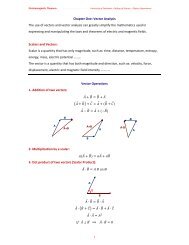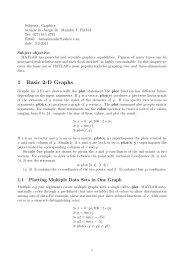Sedimentology Lab 2.pdf - University of Sulaimani
Sedimentology Lab 2.pdf - University of Sulaimani
Sedimentology Lab 2.pdf - University of Sulaimani
Create successful ePaper yourself
Turn your PDF publications into a flip-book with our unique Google optimized e-Paper software.
<strong>University</strong> <strong>of</strong> <strong>Sulaimani</strong><br />
Practical <strong>Sedimentology</strong><br />
College <strong>of</strong> Science<br />
3rd Year Geology<br />
Department <strong>of</strong> Geology 2009-2010<br />
<strong>Lab</strong>. No.2<br />
Terrigenous Clastic sediments<br />
Gravel, sand and mud<br />
The components <strong>of</strong> sediments and sedimentary rocks:<br />
Sediments and sedimentary rocks can be classified by either their constituents or their mode <strong>of</strong><br />
origin or a combination <strong>of</strong> the two. The classification as follows:<br />
- Terrigenous clastic material<br />
- Carbonates<br />
- Evaporites<br />
- Volcanoclastic sediments<br />
- Others<br />
Terrigenous clastic material:<br />
A threefold division on the basis <strong>of</strong> grain size is used:<br />
Gravel >2 mm Sand (2 - l/16) mm Mud (clay and silt) < l/16 mm (< 63µm)<br />
Measurements:<br />
Wentworth scale; is a scale which made on the basis <strong>of</strong> factor <strong>of</strong> 1/2 or 2, means adjacent<br />
classes differ by a factor <strong>of</strong> 1/2 or 2. (e.g. 1, 0.5, 0.25…etc.)<br />
Phi scale (φ): is a numerical representation <strong>of</strong> the Wentworth scale. Phi values are<br />
dimensionless numbers that increase with decreasing particle size. Phi diameter is computed by<br />
taking the negative log <strong>of</strong> the diameter in millimeters.<br />
φ = -log 2 d<br />
d: diameter <strong>of</strong> the particle (mm).<br />
Sieve mesh: which is the number <strong>of</strong> openings per inch <strong>of</strong> screen (Lambe, 1951) or between<br />
the wires are square openings, the number <strong>of</strong> which per unit length give the mesh number<br />
(Tucker, 1988).<br />
Grain size analysis (Granulometric analysis):<br />
Quantitative assessment <strong>of</strong> the percentage <strong>of</strong> different grain sizes in clastic sediments and<br />
sedimentary rocks is called granulometric analysis. The data and measurements <strong>of</strong> the shape <strong>of</strong> clasts<br />
can be used in the deposition and interpretation <strong>of</strong> clastic sedimentary material.
• Gravels; are normally assessed by direct measurement in the field.<br />
• Sands; Sieves and microscopic study. By weighting the contents <strong>of</strong> each sieve the distribution<br />
by weight <strong>of</strong> different size fractions can be determined.<br />
• Silt and clay; most laboratory techniques employed in the granulometric analysis <strong>of</strong> silt and<br />
clay size particles are based on settling velocity relationships predicted by Stokes' law.<br />
Sieve analysis methodology:<br />
1- Heap 500gm <strong>of</strong> sand and gravel into a cone.<br />
2- Cut the cone into quarters with a spatula, reject the first and third or second and fourth quarters,<br />
3- Separate the sand from gravel by sieve 2mm.<br />
4- Separate gravels into its categories (4, 8,16mm).<br />
5- Using the same method coning and quartering, you should have a sample weighting about 50gm.<br />
6- Use a set <strong>of</strong> sieves, in which at the top coarser and downward to finer (1, 0.5, 0.25, 0.125, and<br />
0.0625).<br />
7- Then the set <strong>of</strong> sieves vibrated mechanically by using a shaker for 15 minutes.<br />
8- Weight the remained sand in each sieve separately.<br />
The results from the analyses are plotted in one <strong>of</strong> these forms; either a histogram <strong>of</strong> the weight<br />
percentages <strong>of</strong> each <strong>of</strong> the size fractions, a frequency curve or a cumulative frequency curve.<br />
The coarse sizes plot on the left and the finer material on the right <strong>of</strong> the graph. Then statistical<br />
parameters are calculated:<br />
Mean grain size, mode, median, sorting (standard deviation from a normal distribution), skewness<br />
(an indicator <strong>of</strong> whether the grain size histogram is symmetrical or is skewed to a higher<br />
percentage <strong>of</strong> coarser or finer material) and kurtosis (a value which indicates whether the<br />
histogram has a sharp or a flat top).<br />
Exercises:<br />
1- Convert φ 6 to mm size and 16 mm to φ scale using the equation.<br />
2- Conduct the sieve analysis for a specimen with the weight <strong>of</strong> 500gm, (or the result <strong>of</strong> sieve analysis<br />
as in the table below)<br />
3- Name the sample according to the gravel-sand-silt triangle.<br />
Grain size (mm) φ Wt. (gm) Wt. %<br />
8-4 50<br />
4-2 40<br />
2-1 65.6<br />
1-0.5 164<br />
0.5-0.25 82<br />
0.25-0.125 82<br />
0.125-0.0625 16.4

















